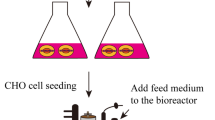Summary
To develop serum-free (SF) media for the production of humanized antibody from recombinant Chinese hamster ovary (rCHO) cells, a statistical optimization approach based on a Plackett-Burman design was adopted. A basal medium was prepared by supplementing α-minimal essential medium (α-MEM) with Fe(NO3)3·9H2O, CuCl2, ZnSO4·7H2O, and Na2SeO3 which are generally contained in SF medium formulations. Insulin, transferrin, and ethanolamine were also supplemented to the basal medium to determine their optimal concentrations. From this statistical analysis, serine, phenylalanine, and tyrosine were identified as important determinants for cell growth. Also, putrescine, linoleic acid, and hydrocortisone were shown to be important for both cell growth and antibody production. The SF medium was formulated by supplementing the basal medium with components showing positive effects on cell growth and/or antibody production. Cell growth and antibody production in this SF medium were comparable to those in α-MEM supplemented with 5% dialyzed fetal bovine serum. Taken together, the results obtained here show that a Plackett-Burman design facilitates the development of SF media for rCHO cells aimed at producing a humanized antibody.
Similar content being viewed by others
References
Barnes, D.; Sato, G. H. Methods for growth of cultured cells in serum-free medium. Anal. Biochem. 102:255–270; 1980.
Bottenstein, J. E.; Sato, G. H. Growth of a rat neuroblastoma cell line in serum-free supplemented medium. Proc. Natl. Acad. Sci. USA 76:514–517; 1979.
Butler, M.; Jenkins, H. Nutritional aspects of the growth of animal cells in culture. J. Biotechnol. 12:97–110; 1989.
Castro, P. M. L.; Hayter, P. M.; Ison, A. P., et al. Application of a statistical design to the optimization of culture medium for recombinant interferon-gamma production by Chinese hamster ovary cells. Appl. Microbiol. Biotechnol. 38:84–90; 1992.
Castro, P. M. L.; Ison, A. P.; Hayter, P. M., et al. CHO cell growth and recombinant interferon-γ production: effects of BSA, pluronic and lipids. Cytotechnology 19:27–36; 1996.
Freshney, R. I. Culture of animal cells: a manual of basic technique. 3rd ed. New York: Wiley J. Liss; 1994:85–98.
Ganne, V.; Mignot, G. Application of statistical design of experiments to the optimization of factor VIII expression by CHO cells. Cytotechnology 6:233–240; 1991.
Glassy, M. C.; Tharakan, J. P.; Chau, P. C. Serum-free media in hybridoma culture and monoclonal antibody production. Biotechnol. Bioeng. 32:1015–1028; 1988.
Hayter, P. M.; Curling, E. M.; Baines, A. J., et al. Chinese hamster ovary cell growth and interferon production kinetics in stirred batch culture. Appl. Microbiol. Biotechnol. 34:559–564; 1991.
Kaufman, R. J.; Sharp, P. A.; Latt, S. A. Evolution of chromosomal regions containing transfected and amplified dihydrofolate reductase sequences. Mol. Cell. Biol. 3:699–711; 1983.
Keen, M. J.; Rapson, N. T. Development of a serum-free culture medium for the large scale production of recombinant protein from a Chinese hamster ovary cell line. Cytotechnology 17:153–163; 1995.
Kim, J. H.; Bae, S. W.; Hong, H. J., et al. Decreased chimeric antibody productivity of KR12H-1 transfectoma during long-term culture results from decreased antibody gene copy number. Biotechnol. Bioeng. 51:479–487; 1996.
Kim, S. J.; Kim, N. S.; Ryu, C. J., et al. Characterization of chimeric antibody producing CHO cells in the course of dihydrofolate reductase-mediated gene amplification and their stability in the absence of selective pressure. Biotechnol. Bioeng. 58:73–84; 1998.
Kovar, J.; Franek, F. Serum-free medium for hybridoma and parental myeloma cell cultivation. Methods Enzymol. 121:277–292; 1986.
Renard, J. M.; Spagnoli, R.; Mazier, C., et al. Evidence that monoclonal antibody production kinetics is related to the integral of viable cells in batch systems. Biotechnol. Lett. 10:91–97; 1988.
Savinell, J. M.; Lee, G. M.; Palsson, B. O. On the orders of magnitude of epigenic dynamics and monoclonal antibody production. Bioprocess Eng. 4:231–234; 1989.
Snell, K.; Natsumeda, Y.; Weber, G. The modulation of serine metabolism in hepatoma 3924A during different phases of cellular proliferation in culture. Biochem. J. 245:609–612; 1987.
Srinivas, M. R. S.; Chand, N.; Lonsane, B. K. Use of Plackett-Burman for rapid design for screening several nitrogen sources, growth/product promoters, minerals and enzyme inducers for the production of alph-agalactosidase by Aspergillus niger MRSS 234 in solid state fermentation system. Bioprocess Eng. 10:139–144; 1994.
Whitfield, J. F.; Boynton, A. L.; MacManus, J. P., et al. In: Waymouth, C.; Ham, R. G.; Chapple, P. J., ed. The growth requirements of vertebrate cells in vitro. London: Cambridge University Press; 1981:160–196.
Zang, M.; Trautmann, H.; Gandor, C., et al. Production of recombinant proteins in Chinese hamster ovary cells using a protein-free cell culture medium. Bio/Technology 13:389–392; 1995.
Author information
Authors and Affiliations
Corresponding author
Rights and permissions
About this article
Cite this article
Kim, E.J., Kim, N.S. & Lee, G.M. Development of a serum-free medium for the production of humanized antibody from chinese hamster ovary cells using a statistical design. In Vitro Cell.Dev.Biol.-Animal 34, 757–761 (1998). https://doi.org/10.1007/s11626-998-0029-6
Received:
Accepted:
Issue Date:
DOI: https://doi.org/10.1007/s11626-998-0029-6




